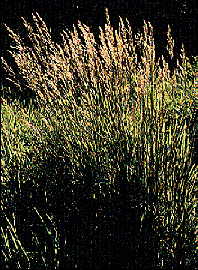Plant Data Sheet
Species:
Bluejoint reedgrass,
Calamagrostis canadensis

photo credit: USGS Northern Prairie Wildlife Research Center
http://www.npwrc.usgs.gov/resource/1998/mnplant/caca.htm
Range:
Widespread throughout North America,
from Alaska to New Foundland, South to New Mexico and North
Carolina.
(Cooke,
1997)
Climate, elevation:
Sea level in northern range to 3,600
meters in New Mexico (Tesky, 1992)
Wetlands in the Tsuga
mertensiana and Abies amabilis zones (Franklin and Dyrness,
1988)
Local occurrence:
Common, but locally abundant
(Pojar and
Mackinnon, 1994)
Habitat preferences:
Moist organic soils, tolerates pH as low as 3.5, does not
tolerate drought. (Tesky, 1992)
Found in upland or wetland (facw+), in ditches or streams,
shorelines, bogs and meadows, moist woodlands. (Cooke, 1997, Pojar and Mackinnon, 1994)
Not found in coastal dunes (See: Calamagrostis
nutkaensis) (Cooke, 1997)
Plant strategy type/successional stage:
Competitive-Ruderal, dominant
species in seral or climax riparian understory. Can invade disturbed areas by
seed, recolonize disturbed areas with residual rhizomes, and can limit woody
vegetation invasion if established densely. (Tesky, 1992)
Associated species:
Salix sp., Carex rostrata,
Epilobium angustifolium (Tesky, 1992)
Carex aquatilis, Scirpus
microcarpus, Glyceria elata,
Eriophorum polystachion, Juncus,
ensifolius (Franklin and Dyrness,
1988)
May be collected as:
Rhizomes
Seeds: late summer or fall (Butler and Frieswyk,
2001)
Collection restrictions or
guidelines:
Flowers late June to mid July
(Tesky, 1992)
Strip seed from stalk (Butler and Frieswyk, 2001)
Seed germination:
90% at 20°C for collected seed in Northwest
territories (Tesky, 1992)
80% when direct seeded, field grown
in western Colorado (Noller, 2001)
"low" when grown in greenhouse in Estes Park Colorado,
germinated in 11 to 14 days
(Butler and Frieswyk, 2001)
Seed life:
Up to 5 years in soil
(Tesky, 1992)
More than 2 years kept cool and
dry (Noller, 2001)
Recommended seed storage
conditions:
Cool and dry (Noller,
2001)
Propagation recommendations:
From Noller (2001):
Cleaned with air screen and debearder,
no pre-treatments,
sowed in field in spring,
2-3 cm deep, 50-70 seeds/30 cm on 1.5 meter rows
From Butler and Frieswyk,
(2001):
Seeds
striped from stalk by hand,
sown in
October and November,
using 30 cm
X 30 cm flat and Fafard superfine germinating mix,
with 19°C
day 13°C night air temperature,
21°C bottom
heat, under a tent with 10 to 15 minute misters.
One week
after germination plants were moved out of tent, misting continued.
Soil or
medium requirements:
See
details above
Installation form:
seed, turf, rhizomes or containers
Recommended planting
density:
50-70 seeds/30 cm on 1.5 meter rows (Noller, 2001)
Care requirements after
installed:
Normal rate of growth or spread;
lifespan:
Grows up to 120 cm, even 200 cm in 6
weeks. Long lived, up to 100 years (Tesky, 1992)
Sources
cited:
Franklin, Jerry and C.T. Dyrness.
1988 Natural Vegetation of Oregon and Washington. Oregon State University Press,
Corvalis, OR 452 p.
Butler, Jennifer; Frieswyk,
Christin. 2001. Propagation protocol for production of Calamagrostis canadensis
seeds; Rocky Mountain National Park, Estes Park, Colorado. In: Native Plant
Network. URL: http://www.nativeplantnetwork.org (accessed 1 May 2003). Moscow
(ID): University of Idaho, College of Natural Resources, Forest Research
Nursery.
Cooke, Sarah Spear. 1997 A Field Guide
to the Common Wetland Plants of Western Washington & Northwestern Oregon.
Seattle Audubon Society, Seattle, WA 415 p.
Noller, Gary L. 2001. Propagation protocol for production of
Calamagrostis canadensis (Michx.) Beauv. plants; Meeker - Upper Colorado
Environmental Plant Materials Center, Meeker, Colorado. In: Native Plant
Network. URL: http://www.nativeplantnetwork.org (accessed 1 May 2003). Moscow
(ID): University of Idaho, College of Natural Resources, Forest Research
Nursery.
Pojar, Jim and Andrew MacKinnon. 1994. Plants of the Pacific Northwest
Coast Washington, Oregon British Columbia & Alaska. BC Ministry of Forests
and Lone Pine Publishing, Vancouver, British Columbia, Canada 527
p.
Tesky,
Julie L. 1992. Calamagrostis canadensis. U.S. Department of Agriculture, Forest
Service, Rocky Mountain Research Station, Fire Sciences Laboratory (2003,
April). Fire Effects Information System, Online. Available:
http://www.fs.fed.us/database/feis/ Accessed 5/1/03.
Data compiled
by:
Matthew Ramsay, May 1, 2003
